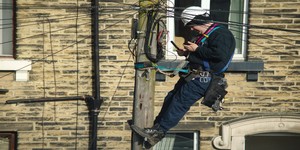ISPs failed to deliver advertised speeds to over 15 million UK households
June 19, 2015 | 10:04

Which? recently revealed the findings of its UK Broadband customer survey and discovered some headline-grabbing, yet unsurprising, results. The consumer watchdog claims that up to 15.4 million households, approximately 75 per cent of Internet-connected UK households, were paying for broadband packages that would never achieve the maximum speeds advertised to them by their provider. The problem was particularly pertinent in rural areas where a staggering 98 per cent of customers recorded speeds below the advertised maximum.
Under current rules laid out by the Advertising Standards Agency (ASA), ISPs can only advertise top speeds if at least 10 per cent of customers can achieve them. Which? claims that just four per cent of TalkTalk's 17Mbps package customers were able to reach those top speeds while a minuscule one per cent of BT customers on its 76Mbps deal could reach advertised bandwidth.
In response to the Which? report ISPs came out in defence of their services with a TalkTalk spokesperson claiming that "Our data, based on over half a million customers, which far exceeds Which's base of a few hundred, shows that TalkTalk homes can achieve speeds beyond 17Mbps". BT made a similar rebuttal with the claim that more than 10 per cent of its super-fast broadband customers could achieve advertised speeds of 80Mbps or more.
Independent communications regulator Ofcom recently altered its Code of Practice to allow broadband customers to walk away from their contracts when speeds fall below acceptable levels and ISPs fail to fix the issue. These new rules, which come into force on June 20th, aim to give consumers more power in the marketplace and ensure ISPs provide a better service for customers.
Under current rules laid out by the Advertising Standards Agency (ASA), ISPs can only advertise top speeds if at least 10 per cent of customers can achieve them. Which? claims that just four per cent of TalkTalk's 17Mbps package customers were able to reach those top speeds while a minuscule one per cent of BT customers on its 76Mbps deal could reach advertised bandwidth.
In response to the Which? report ISPs came out in defence of their services with a TalkTalk spokesperson claiming that "Our data, based on over half a million customers, which far exceeds Which's base of a few hundred, shows that TalkTalk homes can achieve speeds beyond 17Mbps". BT made a similar rebuttal with the claim that more than 10 per cent of its super-fast broadband customers could achieve advertised speeds of 80Mbps or more.
Independent communications regulator Ofcom recently altered its Code of Practice to allow broadband customers to walk away from their contracts when speeds fall below acceptable levels and ISPs fail to fix the issue. These new rules, which come into force on June 20th, aim to give consumers more power in the marketplace and ensure ISPs provide a better service for customers.

MSI MPG Velox 100R Chassis Review
October 14 2021 | 15:04








Want to comment? Please log in.